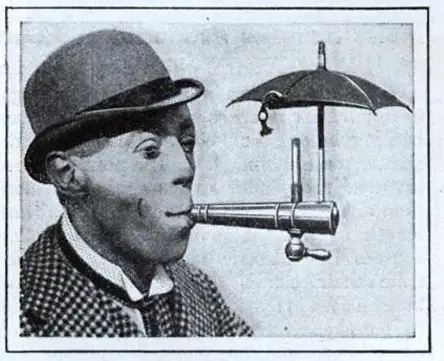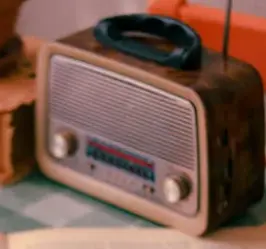Innovation has always been the driving force of progress, but not every invention was a hit when it first came out. Some were brilliantly ahead of their time, solving problems no one realized needed fixing. Others were so outlandish or impractical that they fizzled out almost as quickly as they appeared. Either way, these inventions give us a fascinating glimpse into the minds of the past. Let’s take a look at some of the strangest creations ever made and figure out whether they were strokes of genius or just plain bizarre.
1. The Cigarette Umbrella

In the 1950s, smoking wasn’t just a habit—it was a lifestyle, and inventors were constantly looking for ways to make it more convenient. Enter the cigarette umbrella: a tiny, collapsible canopy designed to protect your cigarette from rain. This bizarre accessory clipped onto the cigarette itself, shielding it from the elements while allowing the smoker to puff away in any weather.
While it might sound laughable today, the cigarette umbrella was a testament to how smoking culture dominated everyday life. It was a creative solution to a problem only smokers faced, but it also underscored the lengths people were willing to go to accommodate the habit. The invention never gained widespread popularity, likely because it was awkward, flimsy, and just plain odd. Still, it’s a fascinating relic from a time when smoking was so ingrained in society that even the rain wasn’t allowed to interrupt it.
2. The Pedal-Powered Hairdryer

Long before electric hairdryers became household staples, there was the pedal-powered version. This contraption required users to pedal furiously to generate the airflow needed to dry their hair. It was essentially a workout and a beauty routine rolled into one, promising a head of dry hair and strong legs at the same time.
While it may seem ridiculous now, the pedal-powered hairdryer was ahead of its time in terms of sustainability. It didn’t require electricity, making it an eco-friendly option in a world that hadn’t yet embraced such ideas. However, the sheer effort it required made it a tough sell. It’s no wonder this invention never gained much traction—literally or figuratively.
3. The Radio Hat

In the 1940s, portable music was still a dream, but the radio hat brought it one step closer to reality. This invention combined a wide-brimmed hat with a built-in AM radio, allowing the wearer to listen to their favorite tunes on the go. It wasn’t the sleekest design, with wires and knobs sticking out, but it was a bold attempt at making portable entertainment a reality.
The radio hat was undeniably ahead of its time, laying the groundwork for modern headphones and earbuds. But its bulky and awkward design kept it from catching on with the mainstream. Still, it’s a reminder that even our most advanced gadgets have humble—and often humorous—beginnings.
4. The Motorized Roller Skates

Why skate with your own leg power when you could strap a pair of tiny gas-powered engines to your feet? That was the thinking behind motorized roller skates, introduced in the 1960s. These skates were equipped with small motors that allowed the wearer to glide along at impressive speeds, provided they could keep their balance.
The skates were undoubtedly innovative, but they were also incredibly dangerous. With no real way to brake and limited control, they turned every outing into a potential disaster. While the idea of motorized skates was ahead of its time, the execution left a lot to be desired. It’s a wonder anyone dared to try them at all.
5. The Face Glove

In the 1920s, beauty enthusiasts were introduced to the face glove, a rubber mask designed to tighten skin and reduce wrinkles. Worn overnight, it promised to rejuvenate the face while you slept. The glove looked more like something out of a horror movie than a beauty product, and the results were dubious at best.
Despite its strange appearance, the face glove was an early attempt at non-invasive skincare treatments. While it didn’t revolutionize the beauty industry, it paved the way for the endless array of anti-aging products we see today. It’s a bizarre relic, but it’s not too far removed from some modern beauty trends.
6. The Pneumatic Subway

In the 1860s, New York City experimented with a subway system powered entirely by air. Passengers were transported through underground tunnels in carriages propelled by pneumatic tubes. It was a quiet, efficient, and futuristic concept that seemed poised to revolutionize urban transit.
Unfortunately, the pneumatic subway never expanded beyond its initial test track. While the idea was brilliant, it lacked the funding and political support needed to take off. Still, it’s a fascinating glimpse at what public transportation could have looked like—and a reminder of how close we came to a quieter commute.
7. The Isolator

The 1920s were a stressful time, and inventor Hugo Gernsback thought he had the solution: the Isolator. This bizarre helmet was designed to block out all noise and distractions, leaving the wearer free to focus completely on their work. It even came with an oxygen tank to ensure uninterrupted breathing.
While the Isolator might look ridiculous, it was a precursor to noise-canceling headphones and other productivity tools. The concept of creating a distraction-free environment was ahead of its time, even if the execution left something to be desired. It’s a strange invention, but its core idea is surprisingly relevant today.
8. The Amphibious Bicycle

Why settle for a regular bike when you could have one that works on both land and water? That was the promise of the amphibious bicycle, a contraption outfitted with floats and paddle wheels. Riders could pedal straight into a lake or river and keep going without missing a beat.
While the concept was undeniably cool, the execution was clunky and impractical. The bike struggled with stability and speed, making it more of a novelty than a reliable mode of transportation. Still, it captured the imagination of inventors and adventurers alike, proving that sometimes the wildest ideas are the most memorable.
9. The Dog-Powered Treadmill

In the early 1900s, treadmills weren’t just for humans—they were for dogs too. The dog-powered treadmill was designed to keep energetic pups active while also generating power for small household tasks like churning butter or grinding grain.
While it seems quaint today, the invention highlights the resourcefulness of the era. People were always looking for ways to make life easier, even if it meant putting their pets to work. The dog-powered treadmill might not fly in today’s world, but it’s a fascinating look at how people harnessed energy in creative ways.
10. The Portable Sauna

In the 1960s, the idea of relaxation on the go took a literal turn with the portable sauna. This invention allowed users to zip themselves into a heated tent that promised all the benefits of a traditional sauna without leaving the comfort of home—or wherever they chose to set it up.
While the portable sauna had its merits, it also came with risks. Overheating and poor ventilation were common complaints, and the device wasn’t exactly user-friendly. Still, it was an early attempt at making wellness accessible, even if it didn’t quite stick the landing.
11. The Anti-Bandit Bag

In the early 20th century, pickpocketing was a major problem, and the anti-bandit bag aimed to solve it. This purse was equipped with a mechanism that caused it to drop its contents or lock shut if tampered with. The idea was to deter thieves by making the bag impossible to steal from.
While innovative, the bag’s design often caused more problems than it solved. Accidental triggers were common, leaving owners scrambling to retrieve their spilled belongings. Despite its flaws, the anti-bandit bag was a creative attempt to tackle a real issue—and it paved the way for modern theft-prevention technology.
12. The Cat-Mewing Alarm Clock

In the 1800s, some alarm clocks were designed to mimic the sound of a meowing cat. The idea was that the gentle, familiar noise would wake sleepers without startling them. The clocks often featured a mechanical cat that “mewed” on cue, making them as entertaining as they were functional.
While charming in concept, the cat-mewing alarm clock didn’t have much staying power. Its novelty wore off quickly, and more reliable alarm systems eventually replaced it. Still, it’s a delightful example of how inventors tried to combine practicality with whimsy.
These inventions remind us that innovation is often a mix of bold ideas and wild experiments. Some were truly ahead of their time, while others were doomed from the start. Either way, they reflect the creativity and determination of their inventors, proving that even the strangest ideas can leave a lasting impression.


